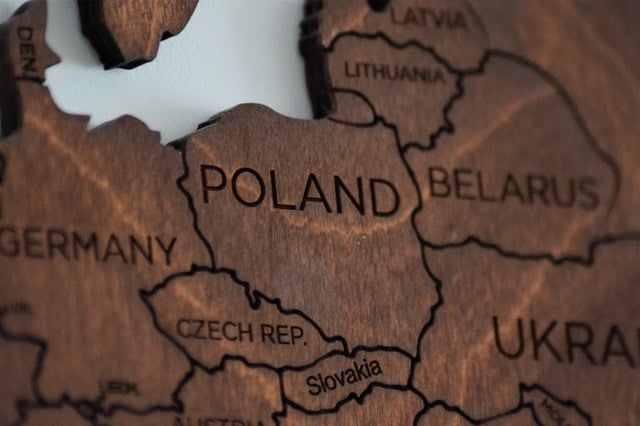Russian vs Polish: Which Language Is Easier to Learn?
Russian and Polish are two closely related Slavic languages that share an intricate history. Today, they will settle old scores and compete against each other in an unprecedented linguistic match with one thing in mind: being chosen as the best language that you, our readers, will want to learn next. Are you ready for a Russian vs Polish linguistic match?
Russian vs Polish – First Round – How Popular Are They?
Polish, a West Slavic language of the Lechitic group, is the national language of Poland and it is spoken as a second language in eastern Germany, northern Czech Republic and Slovakia, western parts of Ukraine and Belarus, as well as in southeast Latvia and Lithuania.
→Sign Up Now: Free Trial Lesson With a Native Teacher!←
It is estimated that around 50 million people speak Polish around the globe, which makes it the sixth most spoken European language.
Russian, on the other hand, an East Slavic language of the Balto-Slavic group, is the official language of Russia, Belarus, Kazakhstan and Kyrgyzstan, as well as a lingua franca in Ukraine, and other former Soviet States.
Today, approximately 260 million people speak Russian of one of its dialects, which makes it not only the most-spoken Slavic language, but one of the most widely spoken languages in the world!
Russian: 1
Polish: 0

Russian vs Polish – Round 2: Which One Is Easier to Write?
Being both Slavic languages, one would expect Russian and Polish to have the same writing system. But things are rarely that straightforward in the fascinating world of language learning!
As it happens, the alphabets of Russian and Polish writing are completely different. The Russian alphabet is a variant of the Cyrillic script first used in the Kievan Rus’ in the 10th century, which originally borrowed characteristics from the Bulgarian alphabet.
In its modern form, it consists of 33 characters:
- twenty consonants: ⟨б⟩, ⟨в⟩, ⟨г⟩, ⟨д⟩, ⟨ж⟩, ⟨з⟩, ⟨к⟩, ⟨л⟩, ⟨м⟩, ⟨н⟩, ⟨п⟩, ⟨р⟩, ⟨с⟩, ⟨т⟩, ⟨ф⟩, ⟨х⟩, ⟨ц⟩, ⟨ч⟩, ⟨ш⟩, ⟨щ⟩
- ten vowels: ⟨а⟩, ⟨е⟩, ⟨ё⟩, ⟨и⟩, ⟨о⟩, ⟨у⟩, ⟨ы⟩, ⟨э⟩, ⟨ю⟩, ⟨я⟩
- a semivowel: ⟨й⟩,
- two modifier letters or “signs”: ⟨ь⟩, ⟨ъ⟩ that indicate how the following letter should be pronounced
Polish, on the other hand, uses Latin letters, which sounds like a nightmare but should actually make you sigh in relief: it is the same alphabet we use in languages like Spanish, French, German, and… English.
Since learning Russian involves mastering a new writing system and Polish doesn’t, we have a clear winner this time.
Russian: 1
Polish: 1
Russian vs Polish – Round 3 – Which One Is Closer to English?
Let’s start by facing the facts: neither language is really close to English. At least, not in the sense that you would find lots of familiar words while reading a Russian or a Polish text. To give you an example, a Spanish person who wants to learn Italian will find that his native language and his target language are strikingly similar:
El hombre está enamorado de una bella mujer. (Spanish)
L’uomo è innamorato di una bella donna. (Italian)
If you expect something like this to happen when you study Russian or Polish, you will be up for a harsh awakening.
Nevertheless, while neither Russian nor Polish are as close to English as Italian is to Spanish, there is one of them that is slightly closer.
As you may know, being a Germanic language, English is quite close to languages like Dutch and German. Polish may not be a Germanic language, but geographical proximity with Germany has led Poles to borrow a significant number of words from German
As a consequence, there are a few Polish idioms and single words that will sound and look familiar to English speakers: artysta (artist), Szkoła (school), woda (water), kolor (color).
On the other hand, though Russian and English are Indo-European languages that ultimately originated from the same source thousands of years ago, they have taken separate paths and grown significantly apart from one another since then. Though it is possible to trace a few common words between Russian and English, sound changes have made eroded almost every similarity.
Unsurprisingly, this one goes to Polish too. (Don’t be mad, Russians!)
Russian: 1
Polish: 2

Russian vs Polish – Round 4 – How Different Are They?
While neither of them is really close to English, they do share multiple words with one another. The tricky part is that, very often, a word that is present in both languages has different meanings in each language. These misleading words, which we call ‘false friends’ because they appear to be one thing but actually end up complicating our lives, include:
| RUSSIAN | POLISH |
| запоминать (to memorize) | zapomniec (to forget) |
| диван (sofa) | dywan (carpet) |
| кровать (bed) | krawat (tie) |
| ягода (berry) | jagoda (blueberry) |
So, next time you see a familiar word in Russian or Polish, beware, it might not mean what you learnt it meant in your previous linguistic venture.
Since learning either Russian or Polish after having learnt the other can be a tricky affair, this round has no winners, which means our score table remains the same.
Russian: 1
Polish: 2
Russian vs Polish – Round 5 – Let’s Talk About Grammar
Finally, the moment you’ve been dreading. The one in which we discuss tenses, word endings, and capricious rules with even more capricious exceptions: the grammar section.
Let us start by saying that coming up with a Russian vs Polish grammar section is not as easy as it may sound. Though these languages are very different in terms of vocabulary and pronunciation, their grammar is quite similar. However, thanks to our Russian teacher, Andrey, I was able to gather some interesting information:
- 1. Forming the past tense is easier in Russian because there are fewer endings to remember. You just have to know the gender and number (singular or plural) of the word and, as Andrey says, “you’re good to go”.
For example:
“Do”
Polish: zrobiłem, zrobiłeś, zrobił
Russian: cделал
“Done”
Polish: zrobiliśmy, zrobiliście, zrobili, zrobiłyśmy, zrobiłyście, zrobiły
Russian: сделали
Well done, Russian!
- 2. In Russian, much like in English, you need to use pronouns at the beginning of almost every phrase to make it clear which person you are talking about. In Polish, this is not necessary:
“I did”
Polish: Zrobiłem
Russian: я сделала
“You draw”
Polish: rysujesz
Russian: ты рисуешь
You go, Polish!
- 3. At the same time, Polish personal pronouns come in two forms: short and long: mnie <–> mi, tobie <–> ci, jego <–> go, etc, a distinction that is non-existent in Russian (as Andrey was almost too happy to mention)
With two points for Russian and one for Polish, we do have a winner this time. But paradoxically, that leaves our two opponents in an anti-climatic tie.
Russian: 2
Polish: 2

Russian vs Polish: Which Slavic Language Is Easier?
Considering everything we’ve said, it is clear that Russian vs Polish are two highly challenging languages that present both advantages and disadvantages for English-speaking learners.
According to the US Foreign Service Institute, which calculates the level of difficulty involved in the learning process of dozens of languages, both Russian and Polish are Category IV languages, which means they present significant cultural and linguistic differences with English. The FSI calculates that it would take an average student 44 weeks or 1100 hours of study to reach fluency in any of these languages.
However, there is one thing that the FSI cannot calculate: motivation. When you put your mind to something, there are no tricky rules or complicated declensions that can get in your way.
So, what can you do to keep motivated while you learn a language as difficult as Russian or Polish?
→Sign Up Now: Free Trial Lesson With a Native Teacher!←
Without a doubt, the best thing you can do is drop your dusty textbook and take a personalized course with a native teacher. Think about it for a second. Who could keep motivated when the only interaction that you get is playing an old CD on your computer or ticking the screen on your smartphone app? On our website, you will find both online and in-person courses that are specifically designed to suit every student’s needs, interests and learning goals. Plus, our native tutors will give you plenty of room for speaking and spontaneous interaction. What are you waiting for? Contact us now and get a free trial lesson, with no strings attached.
